The Brazos Performance Preview: AMD E-350 Benchmarked
by Anand Lal Shimpi on November 16, 2010 12:01 AM ESTMobile IGP Comparison
I narrowed down the platforms for our mobile IGP comparison. I simulated a Core i3 350M by taking an i3-530, underclocking it (I couldn't do anything about the 4MB vs. 3MB L3 cache) and capping its GPU frequency at 667MHz. This is the best case scenario for the i3-350M, and as you'll see below, it doesn't really matter. I also paired a 2.2GHz Pentium Dual-Core with a G45 motherboard, agian simulating the cheaper mobile Pentium platform. Finally I installed Windows 7 on the 1.6GHz Core 2 Duo based 11-inch MacBook Air with its GeForce 320M to give you an idea of the upper bound for mobile performance with what might as well be a low end discrete GPU.
Updated: I've added performance results from a simulated Core i3-330UM, the E-350's competition in ultra portables.
We'll start with Modern Warfare 2:
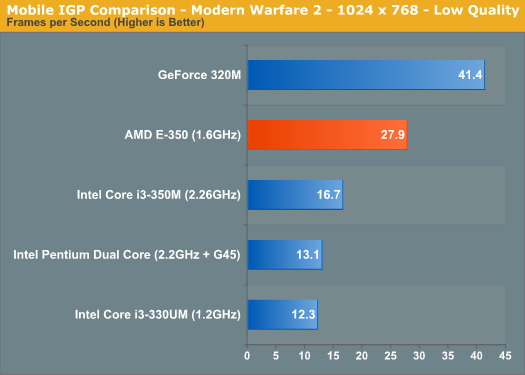
The E-350 puts the i3-350M, i3-330UM and Pentium DC to shame, delivering 67% better performance. The frame rate is just shy of being totally smooth however. I found that in most modern games 1024 x 768 would result in frame rates just under 30 fps.
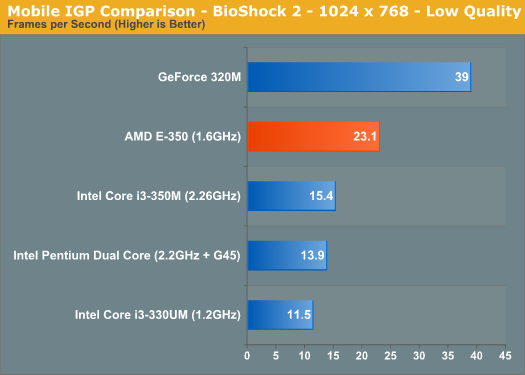
BioShock 2 showed a similar performance advantage. Again we're not able to break 30 fps but the performance advantage is huge compared to the Intel platforms with integrated graphics.
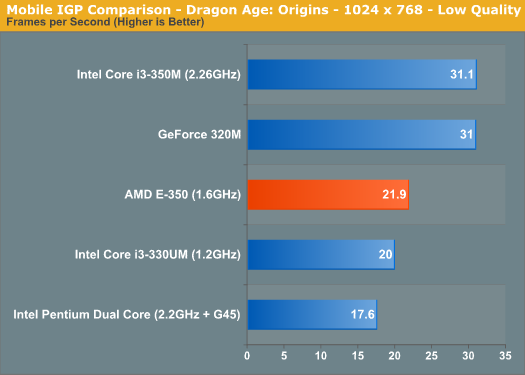
Dragon Age: Origins is mostly CPU bound at low quality settings and thus there's no real advantage to the E-350's Radeon HD 6310 GPU. It's faster than the Pentium/G45 platform, but significantly slower than the i3-350M. I expect most games however to be GPU bound at these settings across the board.
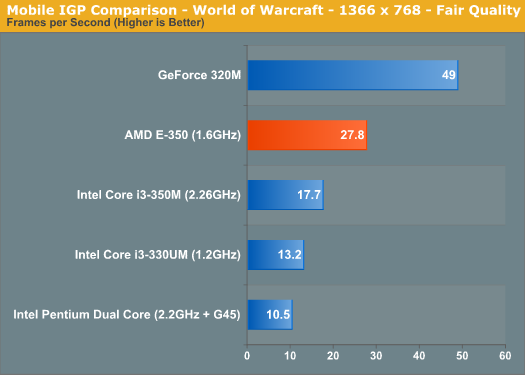
World of Warcraft continued the trend. The E-350 ended up 57% faster than the i3-350M, although still fell short of a discrete GPU.
Of course I wondered how well Brazos would play Starcraft 2:
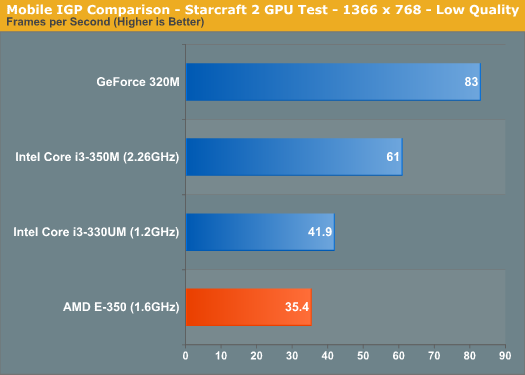
The GPU handles SC2 just fine, however the game is very CPU dependent and thus you see a pretty big advantage from the mainstream i3 system. The comparison is a lot closer when we look at the i3-330UM. The E-350 won't be able to play SC2 as well as a $500 mainstream notebook, but it'll be comparable to an ultraportable running ULV Arrandale.
We don't have numbers for the G45 platform here because the system wouldn't run our benchmark (our tests use an older version of SC2 which apparently had issues with the G45 drivers).
Our SC2 CPU test gives you an idea of the lower end of performance in large multiplayer battles:

The E-350 offers only 58% of the performance of the i3-350M system. The Bobcat cores do hold the platform back from time to time. Again, compared to the i3-330UM there's no performance difference at all.
Just for kicks I also ran the Civilization V benchmark, which gave us two datapoints: GPU performance and no-render/CPU performance.
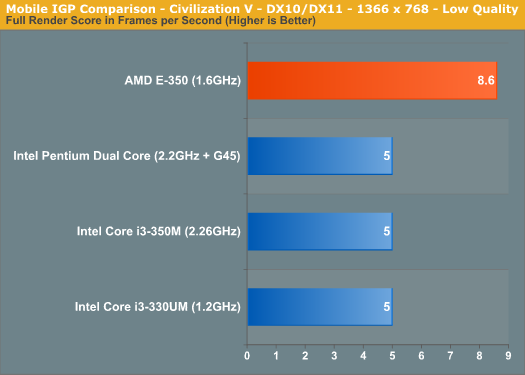
The benchmark doesn't score well on either platform, although AMD does hold a 72% performance advantage over the i3 and G45 platforms. The CPU test puts the E-350 at about 55% of the speed of the Pentium dual core platform.
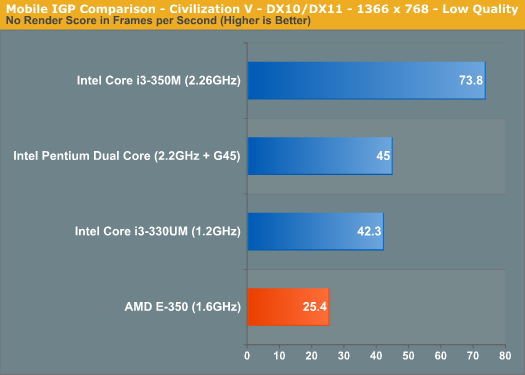
Civ V is one area where the Arrandale CPU advantage wins out over GPU performance.
Overall, the E-350 has no problems outperforming any of the current Intel integrated graphics offerings in 3D games. In CPU bound titles the E-350 loses out to the mainstream i3, but is competitive with ultra low voltage i3s. Just as with Atom, you'll have to sacrifice performance vs. a mainstream notebook, but compared to low voltage Arrandale the E-350 can hold its own.










207 Comments
View All Comments
duploxxx - Tuesday, November 16, 2010 - link
When you mention this:In most of our benchmarks the performance advantage over Atom isn't huge, yet using Brazos is much better than using an Atom based machine. It all boils down to one thing: single threaded performance. Atom can make up for its deficiencies by executing a lot of threads in parallel, but when you're bound by the performance of a single thread the E-350 shines. The E-350 is 65% faster than the Atom D510 in the single threaded Cinebench R10 test. It's this performance advantage that makes the E-350 feel so much quicker than Atom.
and you only post mainly multithreaded apps which are fooled by the HT people off course get a different idea about the final product..... Atom is slow for booting and loading apps, perhaps a real world timing once the final silicon is there and compare the actual timing will give the brazos credit what it needs, afterall its 40nm vs 32nm and first silicon vs 2e revision.
so in the end not that bad, but AMd needs at least a 1.8-2.0GHZ brazos to compete in the 400-500$ range, that should be easy to get, they don't need more gpu power.
btw where is the stated 25W brazos amd has up its sleeves for the ultra low end desktop platform. THey can easily use it for notebooks.
duploxxx - Tuesday, November 16, 2010 - link
sorry anandtech, really big fan of your site, always the first site i will read, but this round other sites have done a much better job then your review. Again even your conclusion is totally off then others who are comparing the right platforms against each other....pcperspective really shows platforms, power consumption and guess what the results are :)
http://www.pcper.com/article.php?aid=1039&type...
Khato - Tuesday, November 16, 2010 - link
Eh, I wouldn't say other sites have done a better job, rather they just present different information. Given the fact that I was primarily interested in GPU performance aspects, the Anandtech review is far more useful far as I'm concerned.That said, the direct comparison against a celeron SU2300 ION platform is indeed interesting. A core 2 duo based celeron at 1.2GHz bests the 1.6GHz 'brazos' in CPU performance on all but the MP3 encode benchmark, which could just as easily be due to differences in the SSD used as the CPU. Sure the power numbers are impressive, but that's quite to be expected on a demo system - it'll be interesting to see how much that goes up on actual retail systems. aka, how stripped down and tweaked was the demo system in order to get idle power that low. It's basically equal to the SU2300 + ION on dynamic power according to those numbers.
duploxxx - Tuesday, November 16, 2010 - link
they all had the same amount of ram and all had ssd in that review, so it is really comaprable, where this review showed lots of different setups.Anand Lal Shimpi - Tuesday, November 16, 2010 - link
My goal was to compare to the type of CPUs you'd find in other $400 - $500 notebooks, mainly ~2.2GHz 1MB L2 Conroe/Merom based CPUs and 2.26GHz Arrandale based chips - both of which you'll see in the review.I agree we needed to include some ULV results, so this morning I added data from a simulated i3-330UM (1.2GHz) across the board :)
Take care,
Anand
khimera2000 - Tuesday, November 16, 2010 - link
intresting... I have to say that I got more out of this review then i did with anand since it uses the profile i would consider buying. I would not consider getting one of these chips for a notebook so the comparison against notebook chips are kinda lost to me.I was intrestead to see how much performance VS how much batterylife this new platform has since i already have a powerful desktop, a comprable notebook I dont need to know how fast a notebook is if its not hitting close to the 8 hour battary mark.
If i where to get one of these it would be for long flights and train rides, it would be for the children in my family, and it would be for the older people who are not as tech enabled. as it stands the questoins i had in mind where not easily answerd by anantech's review.
piroroadkill - Tuesday, November 16, 2010 - link
You've created Atom like performance with a slightly better GPU, way, way too late in the game.I thought the Dual core 1GHz and single core 1.2GHz would be more competitive with Atom 1.6, but looking at these results, those are in with no hope at all.
This is poor.
flyck - Tuesday, November 16, 2010 - link
read the reviews..... performance is better in multithreaded applications than Atom525 with HT and single threaded is 60% faster....gpu is better than ion which atom needs.
powerdraw on idle is LOWER than single core Atom and equal for cpu intensive tasks but higher in games.
mino - Tuesday, November 16, 2010 - link
Games which Atom cannot play in the first place.Not without Ion which makes the battery life goes boom anyway ...
Those GPU's are eating electrons like crazy when doing its job. Sneaky beasts, aren't they ? :D
Khato - Wednesday, November 17, 2010 - link
Really? It's power draw on idle is under the 7 watts measured on Anandtech for the single-core atom N450 Asus 1005PE? Maybe it's power consumption under load is lower than the 9.5 watts for that system?Yeah, power consumption figures vary wildly from system to system, especially when comparing netbook/notebook type designs to nettop/desktop. It's rather clear that the brazos test platform is a netbook/notebook type design and hence has no business being compared to nettop/desktop designs on power consumption.